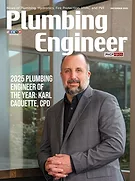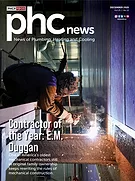I have a potential solution to help solve three problems within the construction industry's skilled labor force. One problem is our industry underutilizes prefabrication. We also need more people to enter the workforce as boomers retire. We further have a unique population of people with plenty of time for training. Now, onto the potential solution: Could imprisoned people prefabricate pieces for your next construction project?
“A survey by the National Association of Home Builders found that builders’ top concern is labor, with 85 percent expecting future cost and availability problems, up from 13 percent in 2011,” notes a January 2021 Bloomberg article (https://bloom.bg/3esXgsz). “It’s a conundrum that predates the [COVID-19] pandemic, but one that’s certainly been exacerbated by it. While unemployment peaked at almost 15 percent in 2020, empty construction jobs nevertheless hovered between 223,000 and 332,000 — about the same number of open slots back when unemployment was only 4.1 percent.”
Unfortunately, people who lost their jobs in 2020 did not apply for open construction jobs (https://bit.ly/3uywKDM). The general public may not think construction is the field for them. They may incorrectly assume every construction position involves using a jackhammer all day.
Why should our workforce extend to the prison system? I recently watched a documentary about a family separated by prison terms. In the movie “Time,” a couple fell on hard times and robbed a bank. They were guilty; the wife was initially sentenced to 12 years, the husband to 60 years.
In an interview with the film’s director Garrett Bradley (https://bit.ly/2RDX2Wj), television host and political commentator Trevor Noah asked about prison terms, specifically what our intention with the punishment should be. She responded: “When you are forced to understand things from a human perspective, from a perspective that requires imagination, where one has to imagine themselves in a situation beyond one which they are already in. It becomes very obvious to me that the system needs to change.”
I do not know what a fair sentence is for specific crimes. There is no easy way to identify a milestone where humans have atoned for their crimes and are ready to reenter the world. Most people in prison will not spend the rest of their lives there. It is reasonable that the willing participants, on good behavior, should be able to prepare themselves to leave prison with skilled labor training.
Breaking the cycle with education
Prison can become an endless cycle for some; however, education can be a major distinction in how people spent their incarcerated time.
The Northwestern Prison Education Program mentions a Bureau of Justice Statistics study (https://bit.ly/3vTkXQn), which “tracked 404,638 prisoners in 30 states after their release from prison, found that 67.8 percent of released prisoners were rearrested within three years of release and more than 76.6 percent were rearrested within five years.”
Northwestern makes an education distinction: “There is a 43 percent reduction in recidivism rates for those prisoners who participate in prison education programs. Indeed, the higher the degree, the lower the recidivism rate is: 14 percent for those who obtain an associate degree, 5.6 percent for those who obtain a bachelor’s degree, and 0 percent for those who obtain a master’s degree.”
Roughly 2.3 million people are incarcerated in the United States. This pool of potential future construction industry workers cannot be overlooked. We are also better off, as a society, if prisoners are given training to help them break the recidivism cycle.
Some people may not want to participate, but most are probably looking for a clear path to stay out of prison. They could immediately benefit the construction industry with the right training. Additionally, controlled environments are ideal for any construction prefabrication.
For the actual training tasks, I am not suggesting we drop a bunch of acetylene torches in the middle of the prison yard and hope they figure out how to solder. I imagine, at a minimum, a bunch of pallets of parts could be organized and prepped for installers into unit-specific boxes for multifamily construction. Who knows, maybe your next Manual J calculation could be sourced through a prison. From what I have seen, motivated prisoners are up for the task.
I helped conduct two prison workforce training programs in the past. Other members of my family, specifically Ellen Rohr and even my grandma, also worked in classrooms behind bars. Hands down, the prisoners I worked with were the most focused and polite students I ever came across.
Continuing education was a privilege for good behavior, and these students made the most of it. I do not know the specifics that landed them in prison, but it does not matter to me. They will leave prison at some point, and they wanted to hit the ground running with knowledge to stay free.
“The national average for inmates receiving the least compensation for their maintenance work in prisons across eight states is 14 cents per hour, according to the nonprofit Prison Policy Initiative,” a Newsweek article reports (https://bit.ly/3b7saEv). “The countrywide average for those receiving the most for the same type of labor is 63 cents per hour. Inmates in Minnesota and New Jersey can receive the highest hourly rate for prison maintenance jobs: $2 per hour.”
A much larger discussion is needed regarding fair labor rates in prison, involving the prisoners themselves. Also, there can be a stigma in the media that using prison labor is distasteful, which should not be the case if the prisoners are willing participants. Under any circumstance, an exceptionally high prison labor hour will probably cost less than anything on a construction site. Additionally, prisoners are capable of more complex work than anecdotal license plate stamping.
States have their own correctional industries programs. At the federal level, there is a Federal Prison Industries program and Prison Industry Enhancement Certification Program. If you are interested, reach out to a local prison and see if there is a win/win scenario with a training and prefabrication program.
Prison prefabrication takes a leap of faith. Do imprisoned people deserve workforce training to give them a second chance? Does the construction industry need to close the skilled labor gap and streamline on-site labor? Is there enough overlap with those two issues to create a prison-to-construction professional pipeline?






